Thompson’s Cider Mill
We visited Thompson’s Cider Mill on Friday, September 22, 2023, and met with owner Geoff Thompson who became interested in making cider in 1975, although his orchard has a long history that dates to the 1870s. Going into the cider mill we were enthralled to hear Geoff’s story and learn how he makes his apple cider, "Voted Best Cider in Hudson Valley by LOHUD.com – The Journal News."
Thompson’s Apples
Thompson’s orchard has 525 trees and sells 50 varieties of apples, which consist of early harvest and late harvest apples. Interesting to note about early harvest apples is that they have a shorter shelf life. An example of an early harvest apple is the Honey Crisp, which is ready to be picked at the end of August and runs until September.
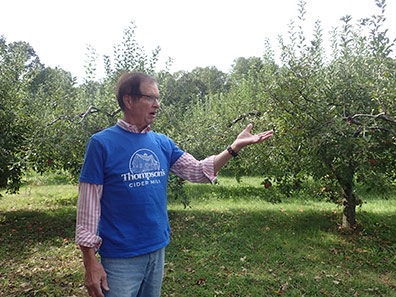
Geoff Thompson and his orchard
Touring the orchard with Geoff we learned that the top states for apple production are Washington, which produces 50% of apples in the United States, with New York State and Michigan also big producers. We also learned about the different varieties of apples he grows by walking through the orchard and tasting the various apples to get a feel for their flavor and textural differences. While we knew several apple varieties, Geoff has some very different apple varieties that we had never heard of before our visit.
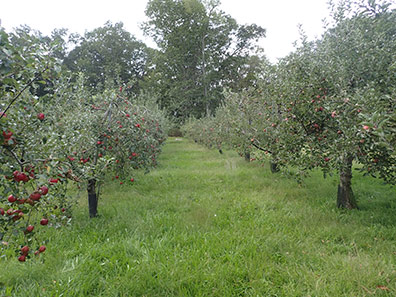
Let’s pick some apples
A Few of the Varieties in Thompson’s Orchard
Westfield Seek-no-Further – identified by its spotting.
Cox’s Orange Pippin – this is a classic English dessert apple with a distinctive orange red skin.
Winter Banana – identified by its yellow skin.
Arkansas Black – ripens late around the 20th of October.
Haralson – introduced in 1922 by the University of Michigan. This apple can withstand very cold temperatures and is very hardy.
Pink Lady – this is the last variety Geoff will pick, around the 10th of November.
Rhode Island Greening – this is a very old American heirloom apple that dates to the 17th century.
Winesap – this variety will be ready to pick mid-October and is exceptionally good for making cider. Geoff likes to use this variety for making his hard cider.
Jonathan – this is a medium-sized sweet apple.
Liberty – this variety was developed by Cornell University and is disease resistant so there is no need for orchards to spray them.
Nehou – this variety is a true cider apple that is bitter to eat, does not last long, and has lots of tannins.
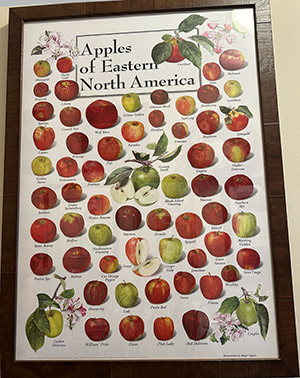
Macintosh – this was the first variety Geoff planted. Interesting to know about "macs" is that they drop their fruit early and picking is usually done by the first of September.
Newtown Pippen – was discovered in Queens, New York. This variety is a winter apple as picking is late in the season in October.
Northern Spies – Geoff likes to use this variety for pies.
Harrison – this variety is a hard cider apple.
Ida Red – this variety hails from the state of Idaho.
Golden Russet – this variety only produces fruit bi-annually.
Roxbury Russet – this apple is believed to be the oldest cultivar in the United States. It is a good winter apple that was first discovered in the mid-17th century in Roxbury, Massachusetts.
White Winter Pearmain – this is an old variety and ripens later in the season around the 20thof October.
Interesting Apple and Cider Facts
Someone that studies or cultivates apples is known as a Pomologist.
Not all apples produce fruit annually, some varieties only produce fruit bi-annually.
Apples are not native to the United States. The colonists brought them to the United States, and thanks in part to the American Pioneer John Chapman (known as Johnny Appleseed) (1774 – 1845) who propagated apples throughout the United States.
Apples are mostly water, and the rainier the season, the larger the apples. When you see apples that are starting to split their skins, this is because they are growing faster than their skins can accommodate their growth. While a rainy season produces apples that are larger and juicier, their sugar content usually is not that sweet.
Apple cider freezes well so you can enjoy cider year-round. To freeze cider, simply lower the level a little in the plastic bottle (to allow expansion when it freezes) and place it in the freezer. Thaw when ready to drink.
The Art of Making Thompson’s Cider
Geoff first selects a blend of apple varieties for his cider and uses a minimum of 10 different varieties. For the first pressing of the season, he used 9 different varieties, for the second pressing, the blend will be about 15 different varieties as the various apples start to ripen. By Thanksgiving, the cider blend can include an exotic mix of up to 50 different varieties.

Collecting the apples to be pressed
The first step is to get the apples into bushel boxes; 40 pounds of apples in a box will yield about 3 gallons of cider. The next step is to empty the boxes of apples into the machine called a hopper that feeds the apples into a washer. The washer is a machine that has a series of rollers and has water spraying down on the apples to clean them. The apples roll down to the bottom of a conveyer that then carries them up and drops them over a shredder.
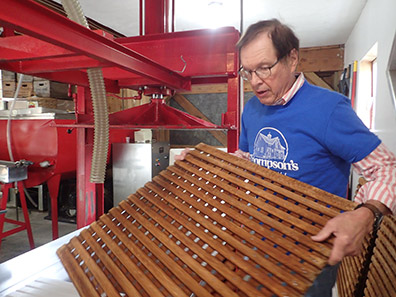
Geoff Thompson showing us the lattice
The whole apple is shredded and dropped down into a hopper. The shredded apple is called pomace. The pomace is pumped from the hopper by a hose onto a cloth, which is folded over several times and acts as a filter.

Spreading the pomace
Between each filled cloth, there is a wood lattice piece made of oak to separate up to 9 layers of pomace-filled cloths. Once 9 cloths are filled, they are winched down under a steel plate to extract as much of the juice as possible and allow the juices to run out through the cloths. The cloths function as filters to prevent any of the apple pieces from getting into the cider.
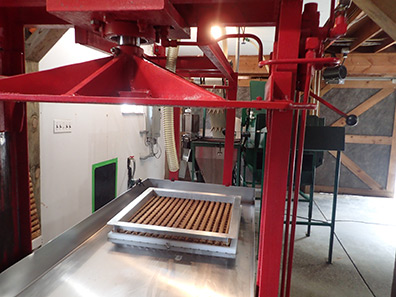
Time to press
The juices then run into a stainless-steel pan, then into a holding basin, and are then pumped past an ultra-violet light required by the state of New York to kill any harmful bacteria that could be present in the cider.
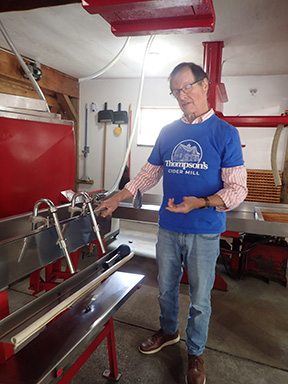
Fill ’em up
The cider is then pumped into a bulk container and refrigerated until it is ready to put into various size containers. Interesting to note is that after the juice is pressed, the remaining pomace on the cloths is put into a bin that goes to the Stone Barns Center for Food & Agriculture to feed the chickens and pigs.
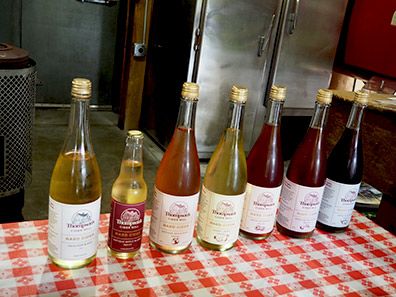
Hard Cider Tasting
After the demo, we tasted the first pressing of cider, and it was delicious! We followed that with a tasting of Thompson’s Hard Ciders, which range from dry to semi-dry, all of which were well crafted and delicious, that you can read about in the Liquor Cabinet section.
We left with wonderful memories of our visit to Thompson’s Cider Mill and brought home a delectable taste of Hudson Valley with a bag of the various apples, cider, and hard ciders. Until next time, cheers and Bon Appetit!
Thompson’s Cider Mill which is open seasonally on Saturdays and Sundays. They are also at Thompson’s at Fable Farm, seasonally on Saturdays and Sundays.
Thompson’s Cider Mill is open seasonally on Saturdays and Sundays from 11:00 am until 5:00 pm. They are located at 335 Blinn Road, Croton-on-Hudson, New York, where they sell apples, cider, and hard ciders.
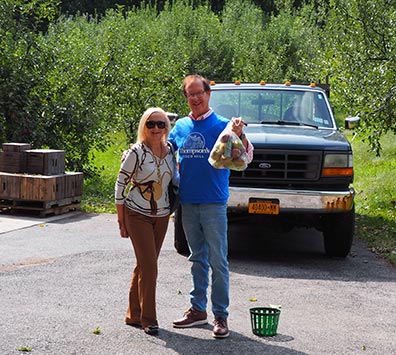
Debra C. Argen and Geoff Thompson showing thier apple pickings
Thompson’s at Fable Farm is also open seasonally on Saturdays and Sundays from 10:00 am until 5:00 pm. The Farm is located at 1311 Kitchowan Road (Route 134), Ossining, New York. They sell fresh apple cider, donuts, apples, pies, and baked goods. They do not sell hard cider at that location.
To learn more about Thompson’s Cider Mill or to purchase their products, please visit their website: www.ThompsonsCiderMill
Thompson’s Cider Mill
335 Blinn Road
Croton-on-Hudson, New York 10520
Telephone: +1-914-409-3433
Email: info@thompsonscidermill.com
Website: www.ThompsonsCiderMill
Facebook: www.Facebook.com/ThompsonsCiderMill
Vimeo: www.vimeo.com/230232408
Read more aboutPeekskill and the areain theDestinations,Hotels and Resorts,Restaurants,Gastronomy,Liquor Cabinet,Adventures, andArts and Antiquessections.
For more information on the Hudson Valley, please visit the website: www.HudsonValley.org and www.VisitWestchesterNY.com
Follow Luxury Experience on YouTube: @edwardnesta9910 @luxurypair
Follow Luxury Experience on Facebook: www.facebook.com/LuxuryExperience
Follow Luxury Experience on Twitter: www.twitter.com/luxurypair @luxurypair
Folllow Luxury Experience on Instagram: www.Instagram.com/luxurypair @luxurypair
© October 2023. Luxury Experience. www.LuxuryExperience.com All rights reserved.

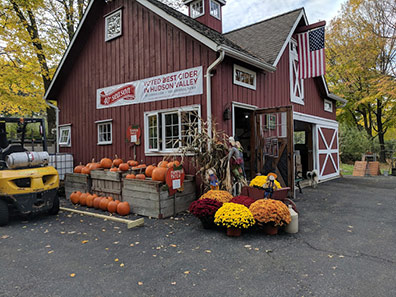

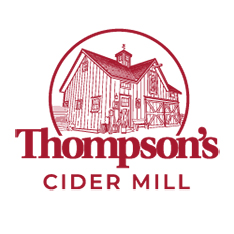
2 comments
[…] Thompson’s Cider Mill Gold Rush Hard Cider […]
[…] Thompson’s Cider Mill Hard Cider Antique Apple Blend, Semi-Dry […]
Comments are closed.